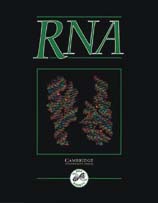Crossref Citations
This article has been cited by the following publications. This list is generated based on data provided by
Crossref.
Arluison, Véronique
Batelier, Gérard
Riès-Kautt, Madeleine
and
Grosjean, Henri
1999.
RNA:pseudouridine synthetase Pus1 from Saccharomyces cerevisiae: Oligomerization property and stoichiometry of the complex with yeast tRNAPhe.
Biochimie,
Vol. 81,
Issue. 7,
p.
751.
Massenet, Séverine
Motorin, Yuri
Lafontaine, Denis L. J.
Hurt, Eduard C.
Grosjean, Henri
and
Branlant, Christiane
1999.
Pseudouridine Mapping in the Saccharomyces cerevisiae Spliceosomal U Small Nuclear RNAs (snRNAs) Reveals that Pseudouridine Synthase Pus1p Exhibits a Dual Substrate Specificity for U2 snRNA and tRNA.
Molecular and Cellular Biology,
Vol. 19,
Issue. 3,
p.
2142.
Simos, George
1999.
Nuclear export of tRNA.
Protoplasma,
Vol. 209,
Issue. 3-4,
p.
173.
Wolin, Sandra L.
and
Matera, A. Gregory
1999.
The trials and travels of tRNA: Figure 1..
Genes & Development,
Vol. 13,
Issue. 1,
p.
1.
Ansmant, I.
Massenet, S.
Grosjean, H.
Motorin, Y.
and
Branlant, C.
2000.
Identification of the Saccharomyces cerevisiae RNA:pseudouridine synthase responsible for formation of 2819 in 21S mitochondrial ribosomal RNA.
Nucleic Acids Research,
Vol. 28,
Issue. 9,
p.
1941.
Großhans, Helge
Lecointe, Francois
Grosjean, Henri
Hurt, Ed
and
Simos, George
2001.
Pus1p-dependent tRNA Pseudouridinylation Becomes Essential When tRNA Biogenesis Is Compromised in Yeast.
Journal of Biological Chemistry,
Vol. 276,
Issue. 49,
p.
46333.
Ansmant, Isabelle
Motorin, Yuri
Massenet, Severine
Grosjean, Henri
and
Branlant, Christiane
2001.
Identification and Characterization of the tRNA:Ψ31-Synthase (Pus6p) of Saccharomyces cerevisiae .
Journal of Biological Chemistry,
Vol. 276,
Issue. 37,
p.
34934.
Ansmant, I.
and
Motorin, Y.
2001.
Identification of RNA Modification Enzymes Using Sequence Homology.
Molecular Biology,
Vol. 35,
Issue. 2,
p.
206.
Lecointe, François
Namy, Olivier
Hatin, Isabelle
Simos, George
Rousset, Jean-Pierre
and
Grosjean, Henri
2002.
Lack of Pseudouridine 38/39 in the Anticodon Arm of Yeast Cytoplasmic tRNA Decreases in Vivo Recoding Efficiency.
Journal of Biological Chemistry,
Vol. 277,
Issue. 34,
p.
30445.
BEHM-ANSMANT, ISABELLE
URBAN, ALAN
MA, XIAOJU
YU, YI-TAO
MOTORIN, YURI
and
BRANLANT, CHRISTIANE
2003.
TheSaccharomyces cerevisiaeU2 snRNA:pseudouridine-synthase Pus7p is a novel multisite–multisubstrate RNA:Ψ-synthase also acting on tRNAs.
RNA,
Vol. 9,
Issue. 11,
p.
1371.
Urban, A
Ansmant, I
and
Motorin, Y
2003.
Optimisation of expression and purification of the recombinant Yol066 (Rib2) protein from Saccharomyces cerevisiae.
Journal of Chromatography B,
Vol. 786,
Issue. 1-2,
p.
187.
Hopper, Anita K.
and
Phizicky, Eric M.
2003.
tRNA transfers to the limelight.
Genes & Development,
Vol. 17,
Issue. 2,
p.
162.
Steiner-Mosonyi, Marta
Leslie, Deena M.
Dehghani, Hesam
Aitchison, John D.
and
Mangroo, Dev
2003.
Utp8p Is an Essential Intranuclear Component of the Nuclear tRNA Export Machinery of Saccharomyces cerevisiae .
Journal of Biological Chemistry,
Vol. 278,
Issue. 34,
p.
32236.
Hori, Hiroyuki
Kubota, Susumu
Watanabe, Kazunori
Kim, Jong-Myong
Ogasawara, Tomio
Sawasaki, Tatsuya
and
Endo, Yaeta
2003.
Aquifex aeolicus tRNA (Gm18) Methyltransferase Has Unique Substrate Specificity.
Journal of Biological Chemistry,
Vol. 278,
Issue. 27,
p.
25081.
JACKMAN, JANE E.
MONTANGE, REBECCA K.
MALIK, HARMIT S.
and
PHIZICKY, ERIC M.
2003.
Identification of the yeast gene encoding the tRNA m1G methyltransferase responsible for modification at position 9.
RNA,
Vol. 9,
Issue. 5,
p.
574.
KAYA, YUSUF
and
OFENGAND, JAMES
2003.
A novel unanticipated type of pseudouridine synthase with homologs in bacteria, archaea, and eukarya.
RNA,
Vol. 9,
Issue. 6,
p.
711.
Chiacchio, Ugo
Corsaro, Antonino
Mates, Juan
Merino, Pedro
Piperno, Anna
Rescifina, Antonio
Romeo, Giovanni
Romeo, Roberto
and
Tejero, Tomas
2003.
Isoxazolidine analogues of pseudouridine: a new class of modified nucleosides.
Tetrahedron,
Vol. 59,
Issue. 26,
p.
4733.
Bykhovskaya, Yelena
Casas, Kari
Mengesha, Emebet
Inbal, Aida
and
Fischel-Ghodsian, Nathan
2004.
Missense Mutation in Pseudouridine Synthase 1 (PUS1) Causes Mitochondrial Myopathy and Sideroblastic Anemia (MLASA).
The American Journal of Human Genetics,
Vol. 74,
Issue. 6,
p.
1303.
Xing, Feng
Hiley, Shawna L.
Hughes, Timothy R.
and
Phizicky, Eric M.
2004.
The Specificities of Four Yeast Dihydrouridine Synthases for Cytoplasmic tRNAs.
Journal of Biological Chemistry,
Vol. 279,
Issue. 17,
p.
17850.
Helm, Mark
and
Attardi, Giuseppe
2004.
Nuclear Control of Cloverleaf Structure of Human Mitochondrial tRNALys.
Journal of Molecular Biology,
Vol. 337,
Issue. 3,
p.
545.

